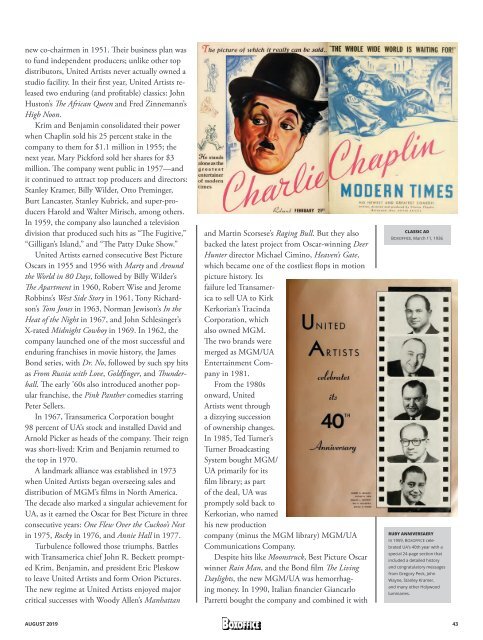Boxoffice - August 2019
The Official Magazine of the National Association of Theatre Owners
The Official Magazine of the National Association of Theatre Owners
Create successful ePaper yourself
Turn your PDF publications into a flip-book with our unique Google optimized e-Paper software.
new co-chairmen in 1951. Their business plan was<br />
to fund independent producers; unlike other top<br />
distributors, United Artists never actually owned a<br />
studio facility. In their first year, United Artists released<br />
two enduring (and profitable) classics: John<br />
Huston’s The African Queen and Fred Zinnemann’s<br />
High Noon.<br />
Krim and Benjamin consolidated their power<br />
when Chaplin sold his 25 percent stake in the<br />
company to them for $1.1 million in 1955; the<br />
next year, Mary Pickford sold her shares for $3<br />
million. The company went public in 1957—and<br />
it continued to attract top producers and directors:<br />
Stanley Kramer, Billy Wilder, Otto Preminger,<br />
Burt Lancaster, Stanley Kubrick, and super-producers<br />
Harold and Walter Mirisch, among others.<br />
In 1959, the company also launched a television<br />
division that produced such hits as “The Fugitive,”<br />
“Gilligan’s Island,” and “The Patty Duke Show.”<br />
United Artists earned consecutive Best Picture<br />
Oscars in 1955 and 1956 with Marty and Around<br />
the World in 80 Days, followed by Billy Wilder’s<br />
The Apartment in 1960, Robert Wise and Jerome<br />
Robbins’s West Side Story in 1961, Tony Richardson’s<br />
Tom Jones in 1963, Norman Jewison’s In the<br />
Heat of the Night in 1967, and John Schlesinger’s<br />
X-rated Midnight Cowboy in 1969. In 1962, the<br />
company launched one of the most successful and<br />
enduring franchises in movie history, the James<br />
Bond series, with Dr. No, followed by such spy hits<br />
as From Russia with Love, Goldfinger, and Thunderball.<br />
The early ’60s also introduced another popular<br />
franchise, the Pink Panther comedies starring<br />
Peter Sellers.<br />
In 1967, Transamerica Corporation bought<br />
98 percent of UA’s stock and installed David and<br />
Arnold Picker as heads of the company. Their reign<br />
was short-lived: Krim and Benjamin returned to<br />
the top in 1970.<br />
A landmark alliance was established in 1973<br />
when United Artists began overseeing sales and<br />
distribution of MGM’s films in North America.<br />
The decade also marked a singular achievement for<br />
UA, as it earned the Oscar for Best Picture in three<br />
consecutive years: One Flew Over the Cuckoo’s Nest<br />
in 1975, Rocky in 1976, and Annie Hall in 1977.<br />
Turbulence followed those triumphs. Battles<br />
with Transamerica chief John R. Beckett prompted<br />
Krim, Benjamin, and president Eric Pleskow<br />
to leave United Artists and form Orion Pictures.<br />
The new regime at United Artists enjoyed major<br />
critical successes with Woody Allen’s Manhattan<br />
and Martin Scorsese’s Raging Bull. But they also<br />
backed the latest project from Oscar-winning Deer<br />
Hunter director Michael Cimino, Heaven’s Gate,<br />
which became one of the costliest flops in motion<br />
picture history. Its<br />
failure led Transamerica<br />
to sell UA to Kirk<br />
Kerkorian’s Tracinda<br />
Corporation, which<br />
also owned MGM.<br />
The two brands were<br />
merged as MGM/UA<br />
Entertainment Company<br />
in 1981.<br />
From the 1980s<br />
onward, United<br />
Artists went through<br />
a dizzying succession<br />
of ownership changes.<br />
In 1985, Ted Turner’s<br />
Turner Broadcasting<br />
System bought MGM/<br />
UA primarily for its<br />
film library; as part<br />
of the deal, UA was<br />
promptly sold back to<br />
Kerkorian, who named<br />
his new production<br />
company (minus the MGM library) MGM/UA<br />
Communications Company.<br />
Despite hits like Moonstruck, Best Picture Oscar<br />
winner Rain Man, and the Bond film The Living<br />
Daylights, the new MGM/UA was hemorrhaging<br />
money. In 1990, Italian financier Giancarlo<br />
Parretti bought the company and combined it with<br />
CLASSIC AD<br />
<strong>Boxoffice</strong>, March 11, 1936<br />
RUBY ANNIVERSAERY<br />
In 1959, <strong>Boxoffice</strong> celebrated<br />
UA’s 40th year with a<br />
special 24-page section that<br />
included a detailed history<br />
and congratulatory messages<br />
from Gregory Peck, John<br />
Wayne, Stanley Kramer,<br />
and many other Holywood<br />
luminaries.<br />
AUGUST <strong>2019</strong><br />
43

















